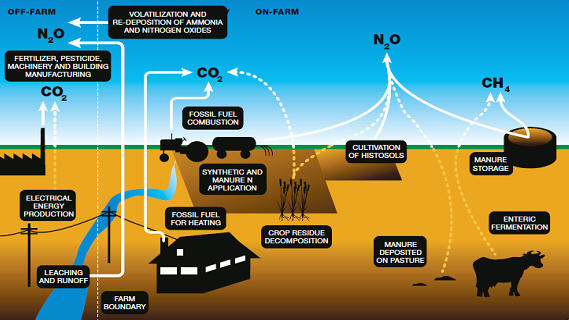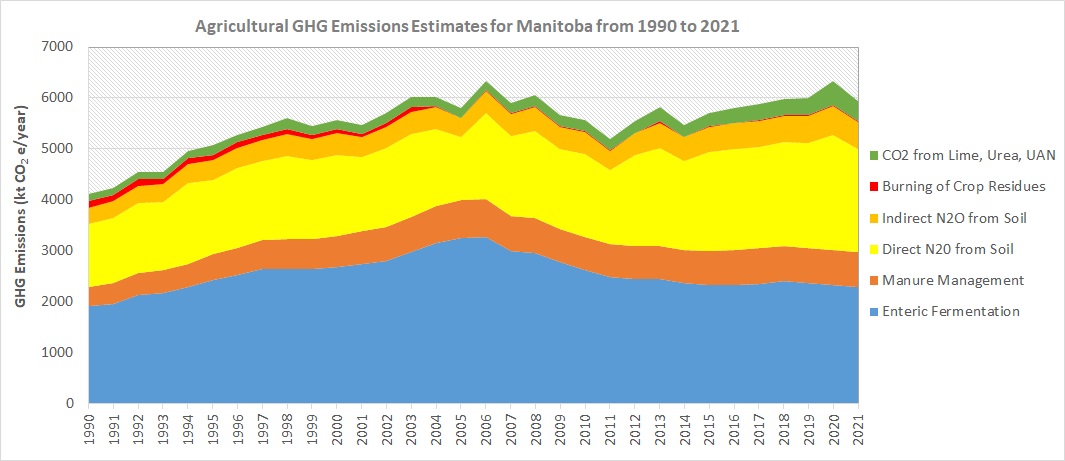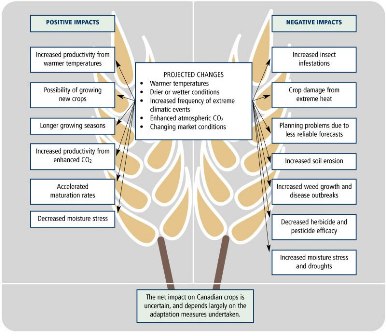Agriculture and Climate Change
Agricultural Greenhouse Gas (GHG) Emissions
While agricultural activities generate emissions from fossil fuel consumption these are reported under the Transportation sub-category in Canada's National Inventory Report. The main GHG emissions categories attributed to agriculture are agricultural soils, enteric fermentation, manure management and CO2 from carbon-containing fertilizers. From within these categories the net GHG emissions in 2021 were roughly 43% N2O (mainly from the use of synthetic N fertilizer for crop production), 50% CH4 (mainly from livestock enteric fermentation and manure management) and 7% from CO2 released after application of carbon-containing fertilizers and crop residue burning.
Nitrous oxide is the major GHG produced from agricultural soils and accounts for about half of Manitoba agriculture's GHG emissions. These emissions can be further broken down into sub-categories:
Direct sources of N2O from soils include use of synthetic fertilizers (largest contributor), livestock manure applied as fertilizer, decomposing crop residue and soil organic matter decay that is stimulated by tillage, summer-fallow, irrigation, and the cultivation of histosols (organic soils).
Indirect sources of N2O from soils are those that come from movement of nitrogen from agricultural soils to surrounding soil or water. When either synthetic fertilizer or manure is applied to agricultural soils, some of the nitrogen is transported off-site through volatilization and subsequent redeposition or through leaching, erosion, and runoff. This nitrogen can then go through subsequent nitrification and denitrification to produce N2O.
Manure is also a source of N2O from agricultural soils. Nitrogen in the manure undergoes transformations, such as ammonification, nitrification, and denitrification that produce N2O.
N2O emissions from agricultural soils not only contribute to agricultural GHG emissions, but also represent a loss of costly nitrogen fertilizers. Therefore there are both environmental and economic benefits for producers to optimize their nitrogen use efficiency by implementing beneficial management practices.
Enteric fermentation makes up the second largest proportion of GHG emissions from agriculture in Manitoba. Methane is released from ruminant livestock as a by-product of digestive fermentation. Significant research has been and continues to be conducted on developing mitigation strategies for enteric CH4 production. Currently there is no long term solution to prevent ruminant methanogenesis, however mitigation options are available such as providing high quality forages to ruminant livestock to improve feed efficiency and managing herd health for maximum growth and reproductive efficiency. Agriculture and Agri-Food Canada (AAFC) scientists at the Lethbridge Research Centre in Alberta are developing methane mitigation strategies for the beef and dairy industries.
Both N2O and CH4 are emitted as a result of manure management, which makes up a relatively small portion of GHG contributions from agriculture in Manitoba. Depending on the manure storage system, the manure characteristics (animal source, solid versus liquid) and the quantity of manure, the amount and type of GHG produced will differ. Manure begins to decompose shortly after it is excreted. Should the conditions be anaerobic (without oxygen) then CH4 is predominately produced; however, if the manure is well aerated then N2O will be the primary GHG produced. This also applies to manure storage facilities; those that are covered and are exposed to little oxygen will primarily produce CH4 and little N2O, while open air manure storage facilities will produce more N2O and little CH4.
A summary of GHG production and elimination for an agricultural setting in Figure 2 shows many sources and sinks. Identifying the major on-farm GHG emissions is the first step to mitigation.

Figure 2. Greenhouse gas sources and sinks within an agricultural system
Source: Greenhouse gases and agriculture | Agriculture and Agri-Food Canada (AAFC)
Potential Climate Change Impacts for Agriculture
(Figure 3, Table 1). In North America, warmer conditions are projected to benefit food production, but strong regional differences are anticipated (Field et al, 2007).
Figure 3. Potential impacts of climate change on agricultural crops in Canada
Source: Natural Resources Canada, Climate Change Impacts and Adaptation: A Canadian Perspective.
Table 1. Potential impacts of climate change on livestock in Canada
| Projected Changes | Positive Impacts | Negative Impacts |
| Warmer Temperatures | Predominately in winter months:
|
Predominately in summer months (heat waves):
|
| Increased frequency of extreme climatic events |
|
|
| Enhanced atmospheric CO2 |
|
|
Source: Natural Resources Canada, Climate Change Impacts and Adaptation: A Canadian Perspective.
The agricultural sector’s vulnerability to climate change is dependent on the nature of climatic change, regional climatic sensitivity and the capacity to adapt to changes (Lemmen and Warren, 2004). Vulnerability to climatic change is multi-dimensional; it is determined by the sector’s response to interacting factors such as economic competition, farm management and cultivar selection, as well as indirect climatic stressors such as water availability and pest competition (Field et al., 2007).
Although the benefits associated with warmer temperatures, longer growing seasons and increased CO2 concentrations are anticipated to deliver benefits to agriculture, other factors may counteract them. The impacts from reduced soil moisture, soil degradation, extreme climatic events and heightened presence of pests could exceed the benefits experienced (Lemmen and Warren, 2004). For benefits to be observed, practices will need to be chosen that can accommodate the current and changing climatic conditions.
References:
Field, C.B., Mortsch, L.D., Brklacich, M., D.I. Kovacs, P., Patz, J.A., Running, S.W. and SCott, M.J. (2007) North America; in Climate Change 2007: Impacts, Adaptation and Vulnerability. (Contribution of Working Group II to th Fourth Assessment Report of the Intergovernmental Panel on Climate Change), (ed) M.L. Parry, O.F. Canziani, J.P. Plautikof, P.J. van der Linden and C.E. Hanson; Cambridge University Press, Cambridge, United Kingdom, p. 617-652.
Lemmen, D. S. and Warren, F. J. eds., Climate Change Impacts and Adaptation: A Canadian Perspective (Ottawa: Climate Change Impacts and Adaptation Directorate, 2004).
For further information, contact your local Manitoba Agriculture Office.



